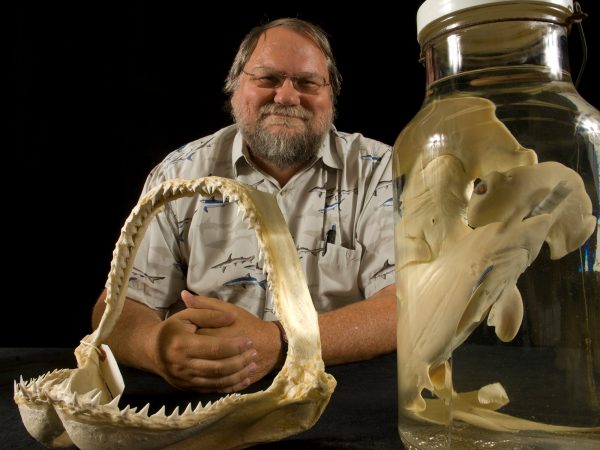Despite last month’s fatality off the Florida coast, the number of shark attacks in the United States continued its downward trend by taking a plunge in the latest recorded year, according to a new report from the Florida Museum of Natural History.
There might not be a sea change in the violent encounters because attacks worldwide edged up from 60 in 2008 to 61 in 2009, said George Burgess, director of the International Shark Attack File at the Florida Museum.
“The big story is that the number of attacks in the United States dropped dramatically from 41 in 2008 to 28 in 2009,” he said. “Considering there were 50 attacks in 2007, we may have a bit of a trend, but only time will tell.”
Florida led the way in the decline in attacks, which fell from 32 in both 2007 and 2008 to 19 in 2009, said Burgess, who released the latest annual shark attack figures today. The file is housed in the Florida Museum on the University of Florida campus.

Florida Museum photo by Eric Zamora
Burgess said the rate of attacks is dictated by the number of sharks and people in the same waters, and yearly variations are common.
A possibility for the decline of assaults in American waters might be the influence of the recession reducing the number of beach-going bathers, Burgess said. “Florida’s population hasn’t gone down, so I suppose the economy could have had an effect on how many times people can afford to put gas in their cars and go to the beach.”
Worldwide, victims died in five attacks, compared with four the previous year. Except for a death in New Caledonia, the fatalities occurred in South Africa, where white sharks congregate in cooler waters, Burgess said. One of the victims was body surfing, another paddle boarding and the other three were surfing, he said.
The United States led the world with 28 attacks, followed by Australia, 20, and South Africa, six. There were two attacks in Egypt and one each in Ecuador, Indonesia, Mozambique, New Caledonia and Viet Nam.
Perhaps more telling than the annual figures is the number of shark attacks in a 10-year period, which rose to unprecedented levels between 2000 and 2010, Burgess said.
“As scientists we don’t get so excited about individual years and tend to look at things in terms of decades,” he said. “The first decade of the 21st century continues a 100-year trend of each decade having more attacks than the previous one, the result of increases in human population and the amount of time spent in recreational activity.”
Conversely, fatality rates have sharply declined. “These first 10 years of the new century have the all-time lowest fatality rate for any decade,” Burgess said.
At the beginning of the 20th century, 60 percent of all shark attacks were fatal, compared with only 7 percent between 2000 and 2010, he said.
“The number of people who died relative to the number of attacks was so high at the beginning of the 20th century in large part because of poor at-the-scene care, no lifeguards and obviously a much more rudimentary ability of medical science to save severe trauma victims,” he said.
In the United States last year, there were 19 attacks in Florida, four in California, three in Hawaii and one each in Texas and Georgia.
“More than half the attacks — 33 out of 61 — were surfers and this continues a trend that we’ve been seeing for quite awhile,” Burgess said.
Swimmers were the second largest group of victims, accounting for 10 of the attacks. The remaining incidents involved scuba diving, swimming, paddle boarding, body surfing, boogie boarding, kite surfing, snorkeling, spear fishing, wading, floating and entering the water, he said.
Within Florida, the county with the largest number of attacks was Volusia, 8, followed by Brevard, 4, Palm Beach, 3, Pinellas 2, and Lee and Monroe, one each.
Volusia County has the dubious distinction of being the world’s shark bite capital as a result of attractive waves off New Smyrna Beach on the central Atlantic coast that are popular with surfers, he said.
“As always, Volusia County was the bell winner,” Burgess said. “Year in and year out there have been more attacks there than anywhere else in Florida. This turned out to be a low year for Volusia County and I’m sure the chamber of commerce was very happy about that.”
In 2009 there were 14 fewer attacks in Volusia County than the previous year, he said.
If the recession contributed to a decline in shark attacks, that would likely show up in Volusia County’s visitor statistics, which draws surfers to its beaches and tourists to Daytona Beach, he said.
Learn more about the Florida Program for Shark Research at the Florida Museum.
Learn more about the Ichthyology Collection at the Florida Museum.